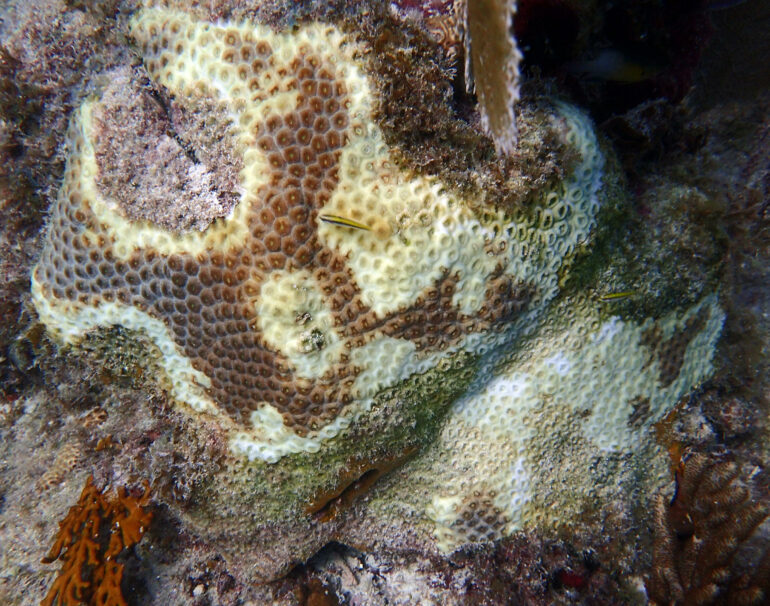by Diana Udel, University of Miami Rosenstiel School of Marine, Atmospheric, and Earth Science
A new study suggests that ships may be spreading a deadly coral disease across Florida and the Caribbean. The findings by scientists at the University of Miami (UM) Rosenstiel School of Marine, Atmospheric, and Earth Science could help establish testing and treatment methods to mitigate the risk of further disease spread.
Stony coral tissue loss disease, or SCTLD, was first observed near Miami in 2014 and has since spread throughout all of Florida’s Coral Reef and into the Caribbean, including in waters off Jamaica, St. Maarten, U.S. Virgin Islands, and Belize.
Researchers suggest that transport through ship hulls, where the vessels take on ballast water in one region to keep it stable and release it at a different port, may have contributed to disease spread.
“Outbreaks in very distant locations suggests that disease transport was aided by means other than just ocean currents, such as through ship ballast water,” said the study’s lead author Michael Studivan, an assistant scientist at the UM Cooperative Institute for Marine and Atmospheric Studies (CIMAS) and NOAA’s Atlantic Oceanographic and Meteorological Laboratory.
In the Experimental Reef Lab at the Rosenstiel School, the researchers conducted two disease transmission experiments of simulated ship’s ballast water and UV treatment of ballast water to determine whether SCTLD pathogens can be transported in this manner, and whether established ballast water treatment approaches like UV can successfully prevent spread of disease.
The first experiment exposed healthy corals to three types of water: 1) disease-exposed, 2) disease-exposed and UV-treated, and 3) non-disease-exposed water in a flow-through tank system.
Over a six-week period, the researchers observed the onset of disease lesions and mortality to determine the number of corals that became diseased, how quickly, and whether UV treatment of disease-exposed water resulted in fewer affected corals.
In a second experiment, the researchers held the same types of water in containers to simulate a ship’s ballast tank for one and five days, then exposed the water to healthy corals to determine whether the SCTLD pathogens could survive over time, and whether they became more or less infectious over time.
The researchers then tested the ballast water generated for both experiments in collaboration with the U.S. Naval Research Laboratory in Key West to quantify the microbial communities and their abundance in untreated and treated ballast water.
“The results suggest that ship’s ballast water poses a threat to continued spread and persistence of SCTLD throughout the Caribbean and potentially to reefs in the Pacific, and that established treatment and testing standards may not mitigate the risk of disease spread,” said Studivan.
The study, titled “Transmission of stony coral tissue loss disease (SCTLD) in simulated ballast water confirms the potential for ship-born spread,” was published on November 1, 2022 in the journal Scientific Reports.
More information:
Michael S. Studivan et al, Transmission of stony coral tissue loss disease (SCTLD) in simulated ballast water confirms the potential for ship-born spread, Scientific Reports (2022). DOI: 10.1038/s41598-022-21868-z
Provided by
University of Miami Rosenstiel School of Marine, Atmospheric, and Earth Science
Citation:
Deadly coral disease in Florida and Caribbean may be transported in ship hulls, study finds (2022, November 17)



